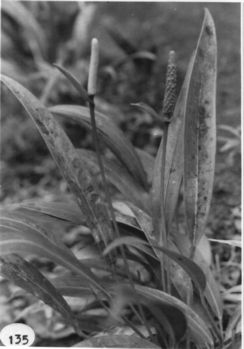




TYPE: Panama. Veraguas: Valley of Río dos Bocas, 11 km NW of Escuela Agricola Alto Piedra (above Santa Fe) on road to Calovebora, 450 m. Croat 27526 (MO 2253471, holotype; B, BR, C. COL, CR, DUKE, F, G, GH, K, M, MEXU, MICH, NY, P, PMA, R, RSA, S, SEL, U, UC, US, VEN, W, isotypes).
LEAVES erect-spreading; petioles terete to ellipsoid in cross-section, or flattened adaxially with a medial rib, 8-19 cm long, usually one-half to three-fourths as long as the blade; geniculum ca. 1 cm long; blades subcori-aceous, narrowly oblong-elliptic to rarely lanceolate-oblong, gradually acuminate at apex (the acumen apiculate), narrowly acute at base, 14-22 cm long, 2.2-4 cm wide, broadest usually at the middle; both surfaces semiglossy, drying more or less matte, sparsely and inconspicuously glandular-punctate on the upper surface, conspicuously glandular-punctate on the lower surface; midrib prominently raised on both surfaces; primary lateral veins 8-10 per side, scarcely or not at all more conspicuous than the interprimary veins, departing midrib at 55÷70° angle, straight or weakly curved to the collective vein; interprimary veins numerous, drying prominulous on both surfaces; collective vein sunken above, raised below, generally more prominent than the lateral veins, inconspicuously loop-connecting the primary lateral veins.
INFLORESCENCE erect-spreading, usually several per plant at flowering time; peduncle terete, 12-28 cm long, 2-3 mm diam.; spathe green, moderately thin, lanceolate, 2.5-4.7 cm long, 5-10 mm wide, broadest usually just above the base, abruptly to gradually acuminate at apex, acute at base, inserted at 45° angle on peduncle; stipe usually to 5 mm long; spadix white at anthesis, moderately tapered to apex, 2.5-4.5 cm long, 3-5 mm diam. near the base, 2-3 mm diam. near the apex; flowers subquadrangular, 2-2.6 mm long, ca. 2.5 mm wide, 3-4 flowers visible in the principal spiral, 4-6 visible in alternate spiral; tcpals semiglossy, the lateral tepals 1-1.4 mm wide, the inner margin thin, obtusely angular, stamens retracted after anthesis; anthers 0.6 mm long, 0.8 mm wide, thecae ovoid, divaricate; pistil early emergent and beginning to color long before maturity.
INFRUCTESCENCE erect; berries (dried) subglo-bose, beaked at apex, red to violet purple, 4-5 mm diam.; seeds 2, tan to brown, 2.4÷2.8 mm long, 1.8-2.1 mm diam., 1-1.3 mm thick, encased in a thin, gelatinous envelope, scarcely elongate at either end. Fig. 135.
Anthurium rupicola is endemic to central Panama in the Provinces of Code and Veraguas at 150 to 800 m in tropical wet and premontane rain forest life zones. The species has been consistently collected on rocks or along the edge of fast moving streams.
It is a member of section Porphyrochitonium and is distinguished by its narrowly lanceolate, long-acuminate, densely and minutely glandular-punctate leaves, its stiffly erect-spreading, lanceolate, green spathe, its white, cylindroid spadix, and by its violet purple berries. The venation of the blades is especially characteristic, with the interprimary veins of dried specimens equally as prominent as the primary lateral veins but less prominent than the collective vein. Anthurium rupicola has been collected in association with A. amnicola, another rupicolous species that differs in having a pale violet purple spathe, a dark violet purple spadix, and leaf blades that are glandular-punctate only on the upper surface.
Anthurium rupicola has been confused with A. lancifolium but the latter diners in being terrestrial or epiphytic (not growing on rocks in and along streams), and in having generally much larger leaves, usually broadest below the middle with the primary lateral veins much more prominent than the interprimary veins. In addition, A. lancifolium generally has a much larger spadix with about five flowers visible in each of the principal spirals.
Two collections from the Choco Department of Colombia (Idrobo 1901, Condole and Juncosa 1175, "La Equis" mine north ofQuibdo-Bolívar road at Km 182-183) are similar to this species, but one is described as having white berries, and the dried glands on the lower blade surface of both collections are very pale, visible only upon magnification. In this respect the Idrobo collection is similar to A. antioquiense Engl., which also has inconspicuously punctate leaf blades. Anthurium antioquiense differs from the Idrobo collection in having a white spathe, a lavender spadix, and blades that have few primary lateral veins drying much more prominent than the interprimary veins. The Idrobo collection has a green spathe and leaf blades with the primary and interprimary veins scarcely distinguishable from one another.

Map of Mesoamerican specimens with coordinates
Panama CoclŽ: 200-400 m, 8.45N 80.35W, 4 Feb. 1983, C. Hamilton &
G. Davidse 2751 (MO).
Panama CoclŽ: 200-400 m, 8.45N 80.35W, 4 Feb. 1983, C. Hamilton &
G. Davidse 2761 (MO).
Panama CoclŽ: 200-400 m,, 3 Feb. 1983, C. Hamilton & G. Davidse
2672 (MO).
Panama CoclŽ: 200-400 m, 8.42.43N 80.37.15W, 3 Feb 1983, G. Davidse
& C.W. Hamilton 23573 (MO).
Panama Veraguas: 380 m, 08.30N 81.07W, 20 March 1987, Gordon McPherson
10705 (MO).
South American Specimens
Colombia Choco: San Francisco de Icho, 150 m,, 09 Jul 1981, Galeano
& Bernal 429 (COL, HUA, NY).